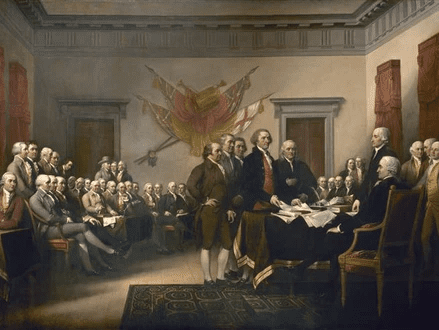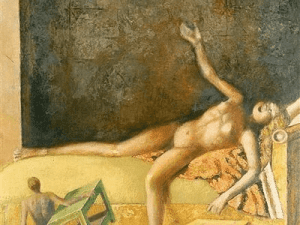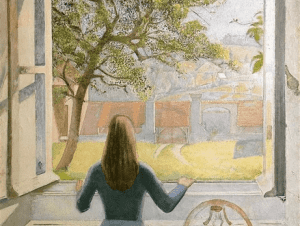Title of Artwork: “Declaration of Independence”

Artwork by John Trumbull
Year Created 1817-1819
Summary of Declaration of Independence
(3.7 by 5.5 m) oil on canvas by American artist John Trumbull, “Declaration of Independence” depicts the presentation of the Declaration of Independence to Congress. On a smaller scale, the Yale University Art Gallery has a replica of the same scene. In order to depict the Second Continental Congress meeting room, Trumbull visited Independence Hall and painted many of the figures from life. Originally commissioned in 1817, the oil-on-canvas piece was purchased in 1819 and finally installed in the Rotunda of the Capitol in 1826.
All About Declaration of Independence
The painting is frequently misidentified as depicting the signing of the Declaration of Independence. In the painting, which depicts the presentation of the Declaration of Independence to Congress on June 28, 1776, the five-man drafting committee is depicted rather than the actual signing of the document.
On this canvas, Trumbull has depicted 42 of the document’s 56 signatories; however, he was unable to secure the likenesses of all 56 signatories in time. Additionally, he depicted several participants in the debate who did not sign the document, including John Dickinson. To fill the void left by the absence of a portrait of Benjamin Harrison V, Trumbull instead used a portrait of the father’s son, Benjamin Harrison VI. The men depicted in the painting were never in the same room at the same time during the deliberations and signing of the Declaration of Independence, which took place as members of Congress changed.
It appears that John Adams’ foot is being stepped on by Thomas Jefferson in the painting, which many thought was a metaphor for their political rivalry. However, closer inspection of the painting reveals that their feet are only a few centimetres from one another. The two-dollar bill version accurately depicted this part of the image.
A different (hopefully clearer) description of where each figure is located in the painting is provided in the key below, which uses the same numbering system as that used by the U.S. government publication “Art of the Capitol” (in the illustration shown in this section), but numbers are not entirely in order.
The following is a key to the figures (listed from left to right in each group):
There are four men on the far right:
There are two people sitting at the table to the left of me:
To Harrison’s right and in front of the standing figures, three people are seated:
On the left, there are five people in a group:
Between the two sets of standing figures, there are three seated figures:
a group of three people standing in the back
There are ten people seated at a table:
The Committee of Five is in front of us:
Four figures in the background, seated near the room’s rightmost corner:
The right-hand corner of the room is occupied by two people:
The central table is occupied by two people:
In the foreground, three people are seated:
Two people sit at the far right of the picture:
This individual was not an original signer of the Declaration of Independence, but he is depicted as such in a work of art). In the earlier Dunlap Broadside, Charles Thomson was listed as having attested to the Declaration of Independence, and many historians believe that he signed the original document that was lost.
Information Citations
En.wikipedia.org, https://en.wikipedia.org/.
Recommend0 recommendationsPublished in Artworks






Responses